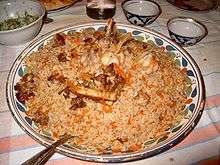Uzbek cuisine

Uzbek cuisine is influenced by local agriculture, as in most nations. There is a great deal of grain farming in Uzbekistan, so breads and noodles are of importance, and Uzbek cuisine has been characterized as "noodle-rich".[1] Mutton is a popular variety of meat due to the abundance of sheep in the country and it is a part of various Uzbek dishes.
Uzbekistan's signature dish is palov (plov or osh or "pilaf"), a main course typically made with rice, pieces of meat, grated carrots and onions. It is usually cooked in a kazan (or deghi) over an open fire; chickpeas, raisins, barberries, or fruit may be added for variation. Although often prepared at home for family and guests by the head of household or the housewife, palov is made on special occasions by the oshpaz, or the osh master chef, who cooks the national dish over an open flame, sometimes serving up to 1,000 people from a single cauldron on holidays or occasions such as weddings. Oshi nahor, or "morning plov", is served in the early morning (between 6 and 9 am) to large gatherings of guests, typically as part of an ongoing wedding celebration.
Other notable national dishes include: shurpa (shurva or shorva), a soup made of large pieces of fatty meat (usually mutton) and fresh vegetables; norin and lagman, noodle-based dishes that may be served as a soup or a main course; manti (also called qasqoni), chuchvara, and somsa, stuffed pockets of dough served as an appetizer or a main course; dimlama (a meat and vegetable stew) and various kebabs, usually served as a main course.
Green tea is the national hot beverage taken throughout the day; teahouses (chaikhanas) are of cultural importance. The more usual black tea is preferred in Tashkent. Both are typically taken without milk or sugar. Tea always accompanies a meal, but it is also a drink of hospitality, automatically offered green or black to every guest. Ayran, a chilled yogurt drink, is popular in the summer, but does not replace hot tea.
The use of alcohol is less widespread than in the west, but wine is comparatively popular for a Muslim nation as Uzbekistan is largely secular. Uzbekistan has 14 wineries, the oldest and most famous being the Khovrenko Winery in Samarkand (est. 1927). The Samarkand Winery produces a range of dessert wines from local grape varieties: Gulyakandoz, Shirin, Aleatiko, and Kabernet likernoe (literally Cabernet dessert wine in Russian).[2][3] Uzbek wines have received international awards and are exported to Russia and other countries in Central Asia.
The choice of desserts in Uzbek cuisines are limited. A typical festive meal ends with fruit or a compote of fresh or dried fruit, followed by nuts and halvah with green tea.
Other Uzbek dishes
- Dholeh - a risotto-like dish.
- Shakarap - a salad of thinly sliced tomatoes and onions with salt and pepper.
- Oshi toki - stuffed grape leaves, similar to dolma, usually served as a cold appetizer.
Breads
.jpg)

Traditional Uzbek bread, called generically noni[4] or patyr, is baked in the form of circular flat loaves (lepyoshka in Russian) with a thin decorated depression at the center and a thicker rim all around. Nons are brought to the table with the decorated side up, then torn into irregular chunks which are stacked on the bread plate. Every region has different varieties of non, most prominent are:
- Obi non is the staple bread of Uzbek cuisine. Obi nons are mentioned in one of the oldest written works, the Epic of Gilgamesh. Obi nons are baked in clay ovens called tandir. "One having eaten in the morning a slice of obi non with raisins, fried peas or Circassian walnut will not be thinking about food for a long time", a quote from Ibn Sina (Avicenna).
- Samarkand non. In different areas of Uzbekistan, obi non is baked in different ways. In Samarkand, small thick obi nons, the shirma nons are the most popular.
- Bukhara obi non sprinkled with sesame or nigella, making a delicate aroma.
- Wedding patir (flaky obi non) from Andijon and Qashqadaryo. According to ancient traditions, this aromatic bread prepared with cream and butter was served during matchmaking meetings.
- Tashkent lochira, plate-formed obi non, baked from short pastry (milk, butter, and sugar). Jirish non is specially prepared bread from flour mixed with wheat. Nomadic tribes did not make tandirs because of their way of living, but cooked bread on butter in kazans (cauldrons), preparing the dough on a milk base.
See also
References
- ↑ "The noodle-rich cuisine of Uzbekistan", The Village Voice, Dining, 19 January 1999.
- ↑ Dessert wines from Uzbekistan (Russian)
- ↑ Tokay-style wines from Uzbekistan (Russian)
- ↑ Hansen, Eric (July–August 2015). "The Fabled Flatbreads of Uzbekistan". AramcoWorld.
External links
| Wikimedia Commons has media related to Cuisine of Uzbekistan. |
- Uzbek restaurant menu in Moscow
- Uzbekistan Food and Dining
- Secrets of the Silk Road: Bukharan Jewish cooking in diaspora
- The Art of Uzbek Cuisine
- Uzbek cuisine
.jpg)
